Introduction: TikTok is a social media application that is an informal hub for health information. One of the prominent health topics on social media is epidural anesthesia. Epidurals decrease the need for systemic medications, effectively lowering the risk of sedation, nausea, and respiratory depression compared to general anesthesia. This study evaluates the relationship between engagement metrics and content quality of TikTok videos related to epidural anesthesia using the DISCERN assessment tool.
Methods: A cross-sectional analysis was conducted on the top 50 TikTok videos under the hashtag "#epidural." Each video was independently evaluated by three medical students using the DISCERN instrument. Engagement metrics-including likes, shares, and saves-were collected and compared against DISCERN scores. Videos were also categorized by author type (healthcare vs. non-healthcare), and statistical comparisons were made using Mann-Whitney U tests.
Results: Healthcare content showed slightly higher DISCERN scores than non-healthcare content, though differences were not statistically significant (p = 0.113). Across all engagement metrics, low-engagement videos generally had higher DISCERN scores, suggesting that higher-quality content does not necessarily translate to broader user interaction. Non-healthcare videos received more likes and saves, indicating greater popularity despite potentially lower quality content.
Conclusion: This study findings underscore the need for healthcare professionals to produce more engaging, high-quality content and increased communication between anesthesiologists and obstetricians. Further research can also be done on how platform algorithms, audience demographics, and posting strategies affect the dissemination of accurate medical information.
Anesthesia, Epidural, Obstetrics, Social media
As technology continues to advance and become a source of medical knowledge, social media has become among the frontrunners for the dissemination of information. Specifically, TikTok, a social media application that uses short videos typically under 60 seconds, is one of the more prominent forms of informal learning today [1]. TikTok boasts over 1.59 billion monthly active users worldwide [2], highlighting its importance as an information hub for health literacy. Studies have shown how TikTok’s design as bite-sized entertainment may additionally be satisfying the young adult’s psychological needs of autonomy and connection, factors which enhance information adoption sometimes more than medical advice from a health professional [3]. The trust and emphasis placed on TikTok as an informal learning resource thus makes it necessary to further evaluate and assess the quality of the information on the application.
Additionally, it should be recognized that TikTok content creators do not always have a medical degree, increasing the risk of consumer misinformation. A previous study evaluated how, in ophthalmology-related content, videos created by non-professionals had a significantly higher rate of misinformation [4]. Consequently, studies have shown that areas of falsification in measles-rubella vaccine content also attract larger numbers of likes, shares and saves, as compared to those without [5], further highlighting the dangers of these information hubs and the need of strict regulation.
Epidural anesthesia involves the injection of a regional anesthetic into the epidural space surrounding the spinal cord [6]. This blocks nerve conduction in targeted spinal segments, providing effective pain relief for post surgery, management of pain during labor and delivery, and chronic pain conditions such as regional pain syndrome and herniated disc [7]. Epidurals allow a patient to have a decreased need for systemic medications, effectively lowering the risk of sedation, nausea, and respiratory depression compared to general anesthesia. Additionally, in obstetrics, an epidural offers the advantage of titratable dosing and the ability to maintain sensation and motor function. Though generally safe, epidurals have potential risk such as hypotension and post-dural puncture headache with more serious complications such as nerve damage and infection [8]. Globally, in developed countries, about 80% of women use epidurals during both vaginal and caesarean-section births [8].
In anesthesiology, as with other medical fields, social media has allowed for great advancements in professional teaching for trainees and global learners with limited access to traditional resources [9]. However, the shortcomings of social media and its inclination towards misinformation on TikTok have not yet been fully assessed in anesthesia. Previously, studies have looked at YouTube and Instagram as outlets of informal education in anesthesiology [10,11]. This study aims to evaluate how epidural anesthesia is portrayed on TikTok and will assess the quality of the information on TikTok using the DISCERN scoring system. DISCERN is an instrument that quantitatively rates response quality, with the goal of influencing evidence-based consumer health education [12]. Through an investigation of epidural anesthesia in the top 50 TikTok videos using the hashtag “#epidural,” the quality of information on epidural anesthesia will be assessed alongside American Society of Anesthesiologist (ASA) guidelines and the DISCERN quality assessment tool.
This is a qualitative cross-sectional study that analyzed videos on TikTok, which is publicly available data making it exempt from Institutional Review Board (IRB) approval under the Common Rule. On June 21 st , 2025, the term epidural was searched using the most recent publicly accessible version of TikTok. To minimize any algorithmic bias, a new, unaffiliated TikTok account was created solely for this study and this account did not engage with content or other users to ensure impartial search results. As mentioned prior, TikTok was chosen due to its growing role as a source of information on social media.
The first 50 videos appearing under the hashtag “#epidural” were included without exclusion. All of the videos were downloaded and stored in a secure online shared folder for analysis. Each video was evaluated independently by three medical students (A.K., J.G., and J.S.) using the DISCERN evaluation system, assigning scores from 1 (low quality) to 5 (high quality) for the various questions. The DISCERN questionnaire is publicly available and used for quality investigation of scientific information. The evaluators underwent a standardized preparation process prior to video assessment to ensure consistent application of the DISCERN scoring system. All three medical student reviewers independently reviewed the official DISCERN handbook and familiarized themselves with each item’s scoring criteria. The graders then participated in a calibration session, during which they collectively scored a set of sample TikTok videos unrelated to the study topic. Any scoring discrepancies were discussed in detail until consensus was reached, clarifying the interpretation of each criterion. This process ensured that all evaluators had a shared understanding of the scoring framework and minimized variability in their independent assessments.
Additional data collected for each video included the author type (healthcare or non-healthcare), the number of likes, shares, and saves. It is important to note that pertaining to the set of 50 videos; healthcare workers fell into the category of physicians, nurses, and physician assistants. The other content authors did not fall into any other healthcare categories and were without training in any clinical field. Mann-Whitney U tests were used to compare the top and bottom 50% of each metric to determine if there were significant differences within the DISCERN scores. Additionally the mean DISCERN scores of the author type were compared.
The comparison between Healthcare and Non-Healthcare content revealed notable but statistically non-significant differences in engagement metrics. Non-Healthcare content showed substantially higher mean Likes (567,800 vs. 237,900; p = 0.059) and Saves (22,000 vs. 9,300; p = 0.157), though these differences did not reach conventional significance thresholds. Shares demonstrated near-identical mean values between sectors (18,300 Non-Healthcare vs. 18,200 Healthcare; p = 0.992), indicating no meaningful difference in sharing behavior. While the pattern suggests Non-Healthcare content may generate higher engagement, the p-values all exceed 0.05, meaning we cannot confidently reject the null hypothesis of equal engagement levels between sectors.
The analysis of DISCERN scores revealed no statistically significant relationships between content quality and engagement metrics. Using a median split approach, the dataset was divided into equal 50/50 groups for each engagement metric: content below the median threshold formed the low-engagement group (bottom 50%), while content at or above the median comprised the high-engagement group (top 50%). For Likes, content below the median threshold (140,300) showed marginally higher median DISCERN scores (40.7) compared to high-engagement content (39.0), though this difference was not significant (p = 0.229). Similarly, Saves demonstrated negligible quality variation between low (39.0) and high (39.3) engagement groups (p = 0.930). While shares showed the largest absolute difference, with low-share content scoring higher (41.0) than high-share content (38.3), this pattern also lacked statistical significance (p = 0.383). Figure 5compares mean DISCERN scores between healthcare and non-healthcare content, showing healthcare content with a slightly higher average score compared to non-healthcare content. While this visual difference suggests healthcare content may have marginally better quality ratings, the lack of statistical significance (p = 0.113) indicates these sector-based differences could be due to random variation rather than meaningful quality distinctions. Table 1 highlights how, given a total of 50 videos, 44% were made by healthcare professionals and 56% were made by those in professions outside of healthcare.
Table 1: Distribution of healthcare vs. non-healthcare content creators. View Table 1
TikTok retains users through its unique algorithm which tailors videos to user interests [13]. This leads to constant use of the social media app in order to amplify self-affirming views [14]. Thus, an analysis of the likes, shares, and saves subsequently identifies trends in views and information. Though the mean likes, shares, and saves received on non-healthcare and healthcare content was non-significant, as seen in Figure 1, non-healthcare content showed substantially higher mean likes, moderately higher saves, and marginally higher shares indicating an increased engagement with content by those not in healthcare. This can lead to engagement with data that is not particularly evidence-based and not created by experts in the field. Furthermore, this suggests that content created by non-healthcare workers are more engaging and possibly more user-friendly than the content being created by those in healthcare.
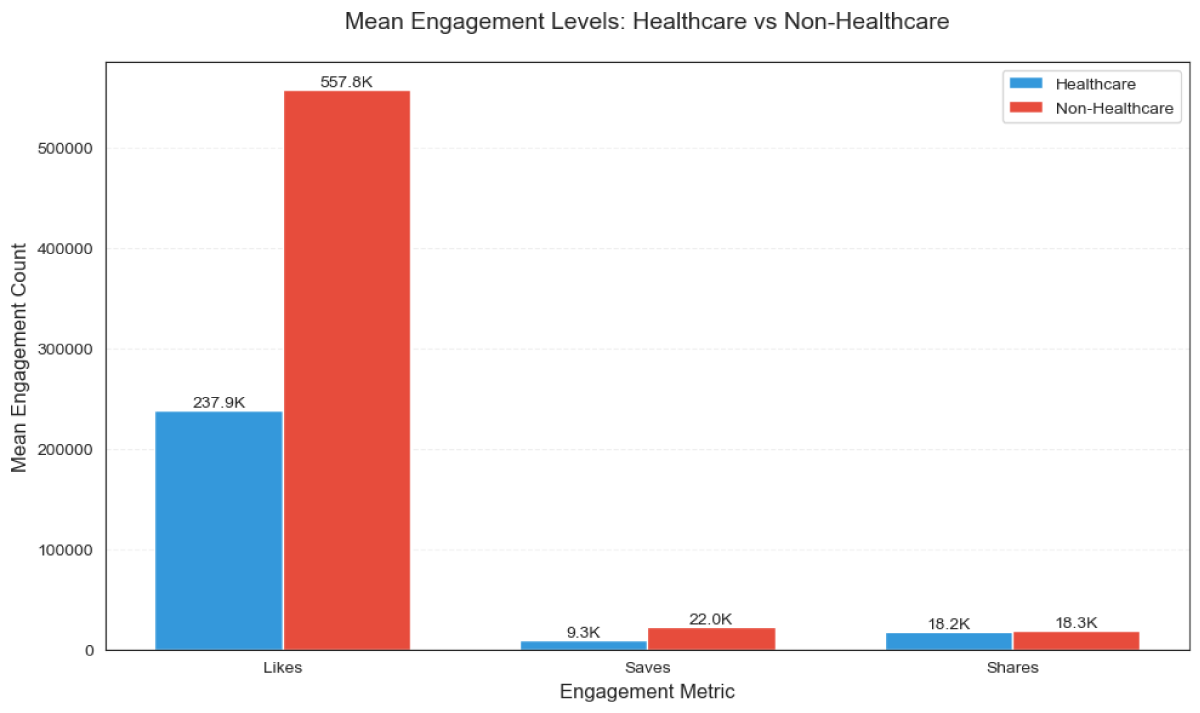 Figure 1: Mean Engagement Levels: Healthcare vs. Non-Healthcare
Figure 1: Mean Engagement Levels: Healthcare vs. Non-Healthcare
Bar graphs compare mean engagement counts (in thousands) for physician- and non-physician-created videos across three metrics: likes, saves, and shares.
View Figure 1
In order to further evaluate the quality of videos, the DISCERN evaluation system was used. DISCERN is a publicly available instrument created to evaluate the quality of scientific information, with the hope of creating evidence-based consumer health education [12]. Though the analysis of DISCERN scores revealed no statistically significant relationships between content quality and engagement metrics, the videos in the low-engagement groups received higher average DISCERN scores in all engagement metrics (Figure 2, Figure 3 and Figure 4). This highlights how videos with a lower user engagement may contain a higher quality of health information, particularly on the understanding of epidural anesthesia for patients. However, a lower level of engagement for higher quality information is a disservice to the content the general population interacts with and receives. Thus, there may be a need for higher quality information to be more visually engaging and interactive with audiences, because user interaction with high-engagement videos leads to a continued populating of similar videos in the algorithm. This would further spread a potentially bigger issue of misinformation in the field of healthcare informatics in social media.
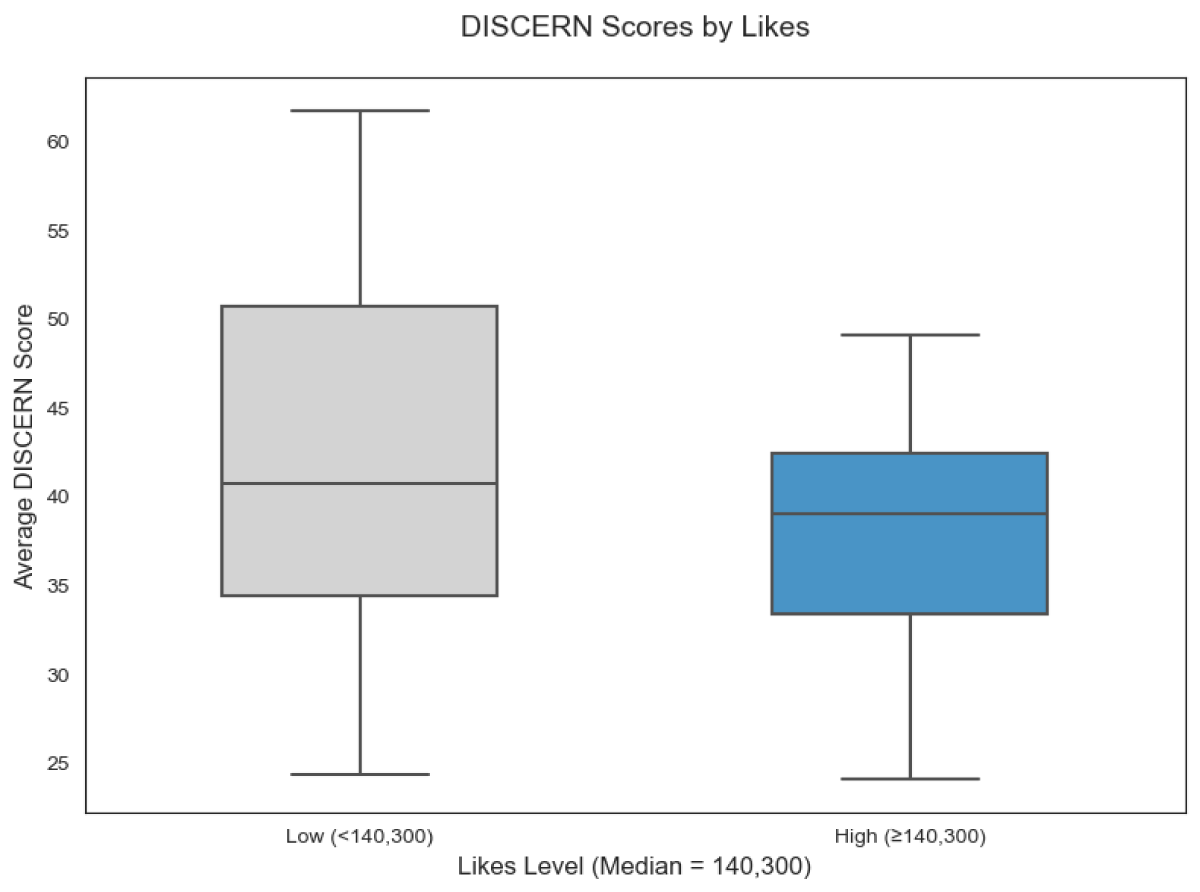 Figure 2: DISCERN scores by likes.
Figure 2: DISCERN scores by likes.
Boxplots illustrate the distribution of average DISCERN scores for videos stratified by number of likes, divided at the median value of 140,300. Boxes represent the interquartile range (IQR), horizontal lines indicate the median, and whiskers denote the full range of observed values.
View Figure 2
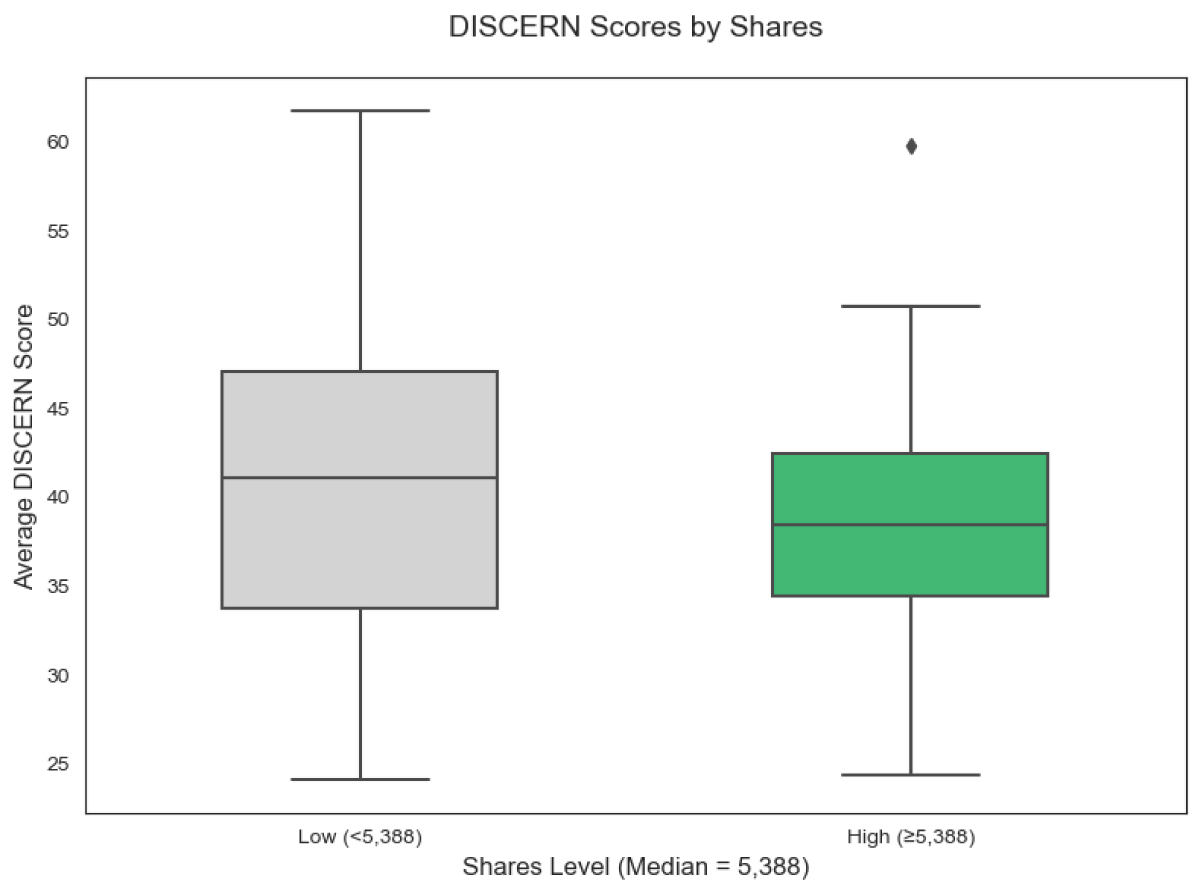 Figure 3: DISCERN scores by shares.
Figure 3: DISCERN scores by shares.
Boxplots present the distribution of average DISCERN scores for videos categorized by share count, split at the median value of 5,388. Boxes denote the interquartile range (IQR), horizontal lines represent the median, and whiskers indicate the observed range of values.
View Figure 3
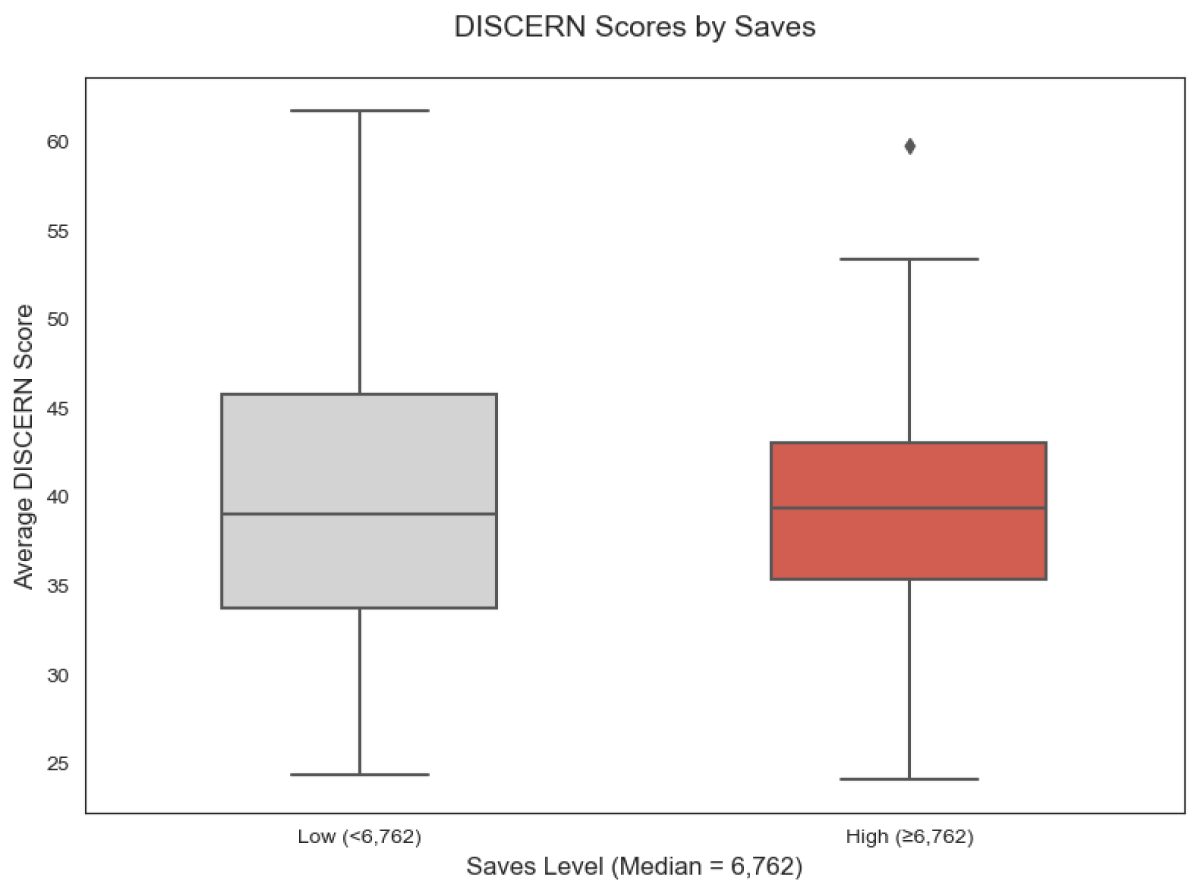 Figure 4: DISCERN scores by saves.
Figure 4: DISCERN scores by saves.
Boxplots display the distribution of average DISCERN scores for videos grouped by saves, split at the median value of 6,762. Boxes represent the interquartile range (IQR), horizontal lines indicate the median, whiskers show the observed range, and outliers are plotted as individual Points.
View Figure 4
Moreover, according to Figure 5, the mean DISCERN score for videos by healthcare professionals has a slightly higher mean DISCERN score than videos by non-healthcare professionals. Though the lack of statistical significance indicates these sector-based differences could be due to random variation rather than meaningful quality distinctions, this difference suggests healthcare content may have marginally better quality ratings. This reinforces the principle that healthcare content provides the general population with better quality of information. Consequently, there needs to be a way to increase engagement with healthcare content to ensure the proper dissemination of medical information.
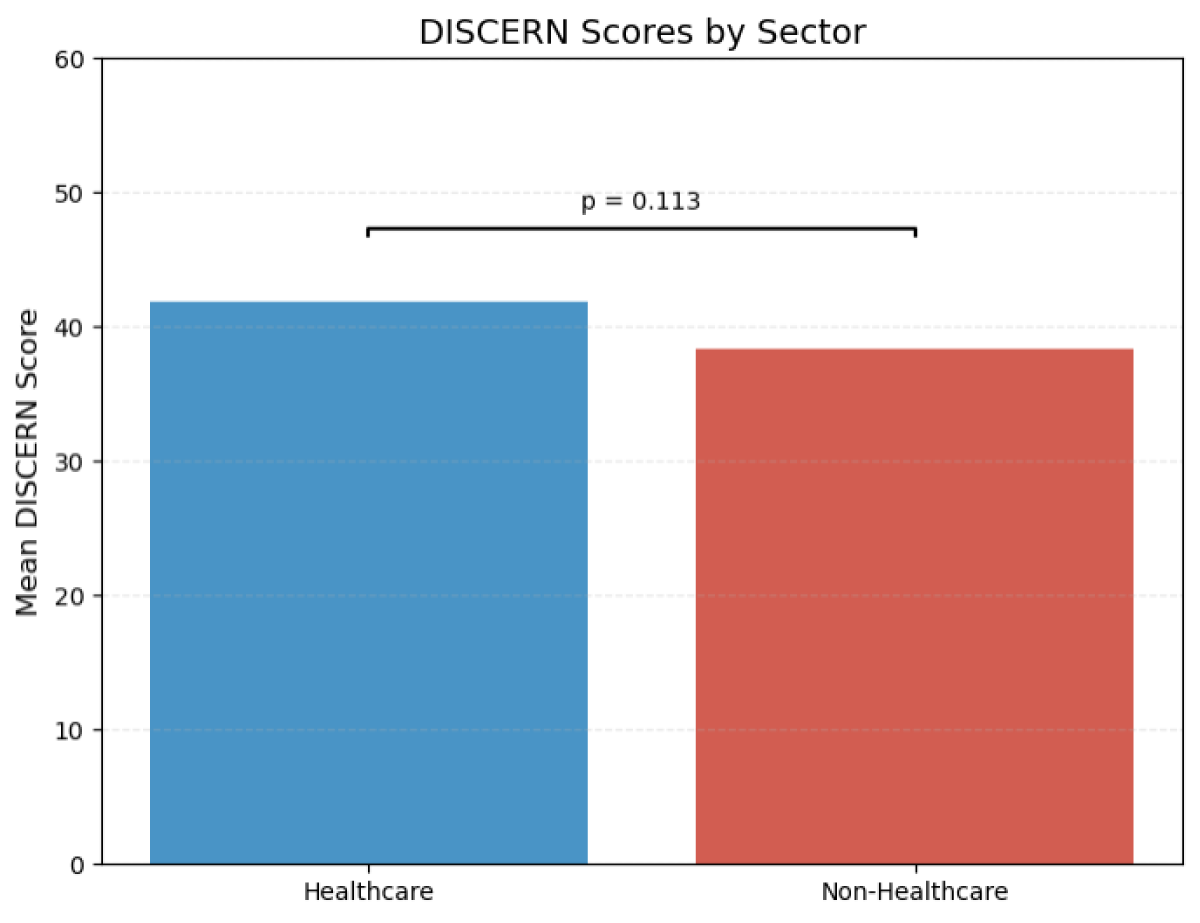 Figure 5: DISCERN Scores by Sector (Healthcare vs. Non-Healthcare).
Figure 5: DISCERN Scores by Sector (Healthcare vs. Non-Healthcare).
The figure compares mean DISCERN scores of physician-created versus non-physician-created videos. Statistical comparison with an independent samples t-test demonstrated no significant difference between groups (p = 0.113).
View Figure 5
Looking at Table 1, a higher percentage of the TikTok videos were made by non-healthcare content creators. Of the videos made by individuals not in healthcare, 50% had negative connotations regarding epidural anesthesia. This makes it harder for individuals to have balanced , informed discussions with their care team. As a majority of the individuals receiving epidurals are pregnant people, an exaggeration of only one view of epidurals can increase anxiety in patients affecting their choice of pain relief during labor. Though there were fewer videos made by individuals in healthcare, all of the videos were non-biased, allowing patients to make informed decisions on the basis of clinical evidence. Though individual experience is important, when individuals without medical training share biased videos on a public domain, it can undermine the voices of OB-GYNs and anesthesiologists.
In spite of the findings of this study, there are a few limitations. Firstly, this study only used a single social media platform to assess the differences in quality across these different metrics. In reality, however, there are a multitude of platforms used by billions of users everyday such as Instagram, Facebook, YouTube, and X (formerly known as Twitter). Additionally, even though the content of the videos was graded independently by three medical students, the individuals reviewing the videos are more familiar with the nuances of medical jargon that may be used in some videos than the common layperson, affecting comprehension of the content of the videos. Thirdly, the 50 videos used in the study were downloaded on one day and were all in English discounting the fluidity of changing content daily and videos present globally influenced by regional cultures [15].
Overall, the findings suggest engagement levels, while numerically distinct, do not conclusively correlate with content quality as measured by DISCERN scores. Sector-specific categorizations (healthcare vs. non-healthcare) similarly do not predictably determine engagement or quality differences. This highlights a potential concern regarding social media platforms: high-quality information might not consistently achieve high engagement, potentially limiting its visibility and dissemination compared to more engaging but possibly lower-quality content. Future studies should consider examining additional variables, such as audience demographics, content format, or temporal posting patterns, which might better explain variations in content engagement and quality. Additionally, refining quality assessment tools or employing multiple scoring systems could yield more nuanced insights into how audiences perceive and interact with various forms of digital content.
This study opens up a conversation on the level of healthcare information on TikTok for contested topics such as epidural anesthesia. There is a need for experienced, well informed voices in this area, with an additional higher level of engagement with users. Changes in TikTok’s algorithm may be warranted if it encourages a spread of health misinformation and further investigation must be done in this area. Nonetheless, it is encouraging to see that high-quality information exists on TikTok, highlighting a potential call to action for healthcare professionals to create more engaging and accessible content.